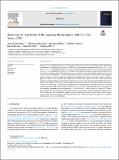Por favor, use este identificador para citar o enlazar a este item:
http://hdl.handle.net/10261/289544COMPARTIR / EXPORTAR:
 SHARE SHARE
 CORE
BASE CORE
BASE
|
|
| Visualizar otros formatos: MARC | Dublin Core | RDF | ORE | MODS | METS | DIDL | DATACITE | |

| Título: | Exploring the variability of the venusian thermosphere with the IPSL Venus GCM |
Autor: | Martinez, Antoine; Lebonnois, Sébastien; Millour, Ehouarn; Pierron, Thomas; Moisan, Enora; Gilli, G.; Lefèvre, Franck | Palabras clave: | Venus Thermosphere Modeling Composition Solar cycle |
Fecha de publicación: | 1-ene-2023 | Editor: | Elsevier | Citación: | Icarus 389: 115272 (2023) | Resumen: | Recent simulations of the Institut Pierre-Simon Laplace (IPSL) Venus Global Climate Model (VGCM) developed at the Laboratoire de Météorologie Dynamique (LMD) were performed with a model top raised from ∼10−5 (∼150 km) to ∼10−8 Pa (180–250 km; upper boundary). The parameterizations of non-LTE CO2 near infrared heating rates and of non-orographic gravity waves were improved. In addition, a tuning of atomic oxygen production was introduced to improve related effects (heating and cooling) and resulting thermospheric number densities. This work focusses on validating the modelled thermospheric structure using data from the Pioneer Venus, Magellan and Venus Express missions which cover similar and complementary (equator and pole) regions at different periods of solar activity, typically above altitudes of 130 km. This version of the IPSL VGCM shows good agreement with the diurnal evolution of the exospheric temperature at the equator reconstructed from the atomic oxygen scale height of the Pioneer Venus Orbiter Neutral Mass Spectrometer data. The model is also able to reproduce the sensitivity of the exospheric temperature and species density to the EUV flux of the solar high activity period (from 180 to 230 solar flux unit; s.f.u). However, to fit with the PV-ONMS density observations, it was necessary to increase the photodissociation of CO2 into CO and O above 135 km by a factor of 10. Indeed, our study points to the importance of an additional source of oxygen and carbon monoxide production above 130 km other than CO2 photolysis to explain the vertical profiles of CO and O number density in the thermosphere. Moreover, the presence of a GW drag at altitudes above 140 km has a significant impact on the nightside temperature value and its distribution. © 2022 The Authors. Published by Elsevier Inc. | Descripción: | This is an open access article under the CC BY-NC-ND licens (http://creativecommons.org/licenses/by-nc-nd/4.0/). | Versión del editor: | http://dx.doi.org/10.1016/j.icarus.2022.115272 | URI: | http://hdl.handle.net/10261/289544 | DOI: | 10.1016/j.icarus.2022.115272 | ISSN: | 0019-1035 | E-ISSN: | 1090-2643 |
| Aparece en las colecciones: | (IAA) Artículos |
Ficheros en este ítem:
| Fichero | Descripción | Tamaño | Formato | |
|---|---|---|---|---|
| 2023Icar..38915272M.pdf | 4,9 MB | Adobe PDF |  Visualizar/Abrir |
CORE Recommender
SCOPUSTM
Citations
4
checked on 01-may-2024
WEB OF SCIENCETM
Citations
2
checked on 20-feb-2024
Page view(s)
30
checked on 05-may-2024
Download(s)
21
checked on 05-may-2024
Google ScholarTM
Check
Altmetric
Altmetric
Este item está licenciado bajo una Licencia Creative Commons

